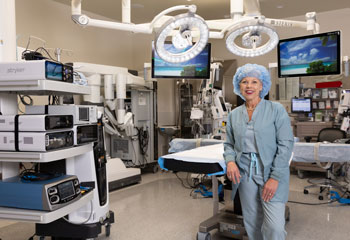
ECMO (Extracorporeal Membrane Oxygenation) Device
The ECMO device is a temporary heart-lung machine. It circulates oxygenated blood, letting your organs rest before getting a transplant or procedure.
Our approach to ECMO
Our UCI Health heart failure team has helped hundreds of people with heart failure live longer, more active lives. As Orange County’s most advanced cardiovascular program, we offer ECMO and other leading-edge devices, including:
Our approach to care is to provide the best patient experience possible. A minimally invasive device like the ECMO reduces stress while managing a critical illness.
When you’re experiencing congestive heart failure or severe, life-threatening lung failure, your body needs help circulating oxygenated blood. With the help of heart-lung bypass support outside of your body, your organs can rest.
How to work with us
The ECMO device gives critical life support if you have advanced heart and/or lung failure. You would already be in our care, have come in through the emergency department or been referred by your doctor.
Make an appointment with our Cardiology Services program if you need a consultation.
Am I a candidate for ECMO?
Our cardiologists may recommend ECMO for you if:
- You’re waiting for heart, lung or other organ transplants
- You’re in shock after a massive heart attack
- You have severe heart and lung disease
- You’re experiencing severe lung damage from infection
- You suffer from extreme trauma
- Your heart can’t pump enough blood to the body
- Your lungs can’t provide enough oxygen, even when given extra oxygen
- Your lungs can’t expel carbon dioxide, even with help from a mechanical ventilator
How long can I use an ECMO machine?
Although we use ECMO devices in cases of extreme congestive heart failure, it is a temporary solution.
We can keep you on an ECMO device for several hours, days, or even weeks. It depends on your specific needs.
If you need longer term assistance, you may benefit from using an LVAD (left ventricular assistive device) instead. The LVAD is a more permanent version of the ECMO.
Does the heart still beat on ECMO?
Yes, it does, but your heart has a much easier time because the device is doing all the work.
What is the next step after ECMO?
We take you off the ECMO gradually to allow your heart and lungs to become stable and eventually take over. There’s a surgical procedure to remove the tubes or cannulas from your body. Afterwards, we may put you on a ventilator.
The next step depends on your specific condition. If you’re waiting for a heart or lung transplant, surgery would be followed by recovery and then physical therapy.
Benefits of an ECMO device
The ECMO device allows your heart or lungs to rest while you await further treatment.This life saving machine keeps blood moving through your body and your oxygen levels balanced. It reduces strain on your organs, giving them time to heal.
Having an ECMO device at UCI Health is the closest thing to being a Level One trauma center. It’s not a treatment you would seek, but it’s an incredible safety net if you need it.
What to expect
Getting an ECMO device is a minimally invasive surgical procedure that takes less than an hour. At UCI Health, we have an experienced team dedicated to ensure every step of the surgery goes smoothly.Our team will take several steps before inserting the ECMO device, including:
Giving you general anesthesia to keep you asleep and comfortable throughout the procedure
During the surgery, our cardiac surgeons insert tubes into your arteries and veins.
The ECMO device pumps blood from your body into an artificial lung to remove carbon dioxide and add oxygen. It then shuttles the oxygenated blood back into your body.
What happens after my ECMO is attached?
After ECMO surgery
Immediately after your ECMO surgery, you’ll recover in our cardiac intensive care unit for several days. ECMO specialists, called perfusionists, monitor you to ensure you recover smoothly and that your ECMO device works properly.Follow-up care after ECMO surgery
Depending on your needs, you may use the ECMO machine for several days or even weeks. If you need long-term assistance, you may benefit from the left ventricular assist device (LVAD).We will follow up with you regularly after your procedure to monitor your progress.
Why choose UCI Health for ECMO?
Multidisciplinary care
As Orange County’s most advanced cardiovascular disease program, we offer ECMO and other leading-edge devices such as LVAD and TAVR. If you need an ECMO device, you’ll have a multidisciplinary team of heart failure specialists in your corner at UCI Health. This includes heart surgeons, cardiologists, nurse practitioners and more. Your team will guide you every step of the way before, during and after the procedure.
We are the preeminent ECMO center in Orange County
If you need an ECMO device, you’ll likely be on it for days to weeks. You’ll need a dedicated team to manage your care throughout the process. We're the only hospital in Orange County with the infrastructure to seamlessly oversee and manage you long-term on this device.
Partnership with referring physicians
As the only academic health system in Orange County, UCI Health specializes in treating people with even the most advanced heart failure. Other cardiologists throughout the region routinely refer and transfer patients to our ECMO program.
Nationally recognized heart failure care
Our multidisciplinary heart failure care team focuses on alleviating your symptoms and strengthening your heart health. Combining expertise, research and innovation, we offer you the most comprehensive heart failure care available.
This is just one reason our program earned the Gold Seal of Approval certification from The Joint Commission. It’s also why we consistently earn the American Heart Association's Gold Plus Award for meeting the highest standard of care for heart failure.
Leaders in heart failure research
We continue to pave the way for new treatments. As the only academic health system in Orange County, UCI Health leads and participates in research and clinical trials. These trials look at new ways to treat heart failure and other types of heart disease. That means you may have access to treatments that are not yet widely available.

An ECMO device is here if you need it
One of our board-certified cardiologists will evaluate your case to see if you need an ECMO device or a different treatment.
Call 714-456-6699 to make an appointment, or
We welcome referrals from community physicians
Refer your patient to our expert cardiologists.
Featured Blog Posts

Are menopause test kits worthwhile?

Rethinking surgery for a next-generation hospital





